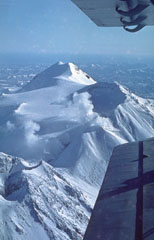Report on Zhupanovsky (Russia) — 23 October-29 October 2013
Smithsonian Institution / US Geological Survey
Weekly Volcanic Activity Report, 23 October-29 October 2013
Managing Editor: Sally Sennert.
Please cite this report as:
Global Volcanism Program, 2013. Report on Zhupanovsky (Russia) (Sennert, S, ed.). Weekly Volcanic Activity Report, 23 October-29 October 2013. Smithsonian Institution and US Geological Survey.
Zhupanovsky
Russia
53.589°N, 159.15°E; summit elev. 2899 m
All times are local (unless otherwise noted)
KVERT reported that a weak thermal anomaly over Zhupanovsky was detected on 23 October. The next day a phreatic eruption began at about 0300 and generated an ash plume that rose 5 km (16,400 ft) a.s.l. The ash plume was visible in satellite images drifting 40 km SE and S. Ash deposits about 10 cm thick were visible at the summit of the central part of the volcano, and deposits about 1 mm thick covered the Nalychevo Valley. The Aviation Color Code was raised to Orange. Ash plumes at 1635 and 2218 rose to altitudes of 2.5-3 km (8,200-10,000 ft) a.s.l. and drifted 120 km ESE and 25 km S, respectively. At 1134 on 25 October an ash plume rose 3 km (10,000 ft) a.s.l. and drifted 20 km NE. On 27 October KVERT noted that strong fumarolic activity and gas emissions continued, but that the phreatic explosions likely had ceased. The Aviation Color Code was lowered to Yellow, and then lowered again to Green on 29 October.
Geological Summary. The Zhupanovsky volcanic massif consists of four overlapping stratovolcanoes along a WNW-trending ridge. The elongated complex was constructed within a Pliocene-early Pleistocene caldera whose rim is exposed only on the eastern side. Three of the stratovolcanoes were built during the Pleistocene. An early Holocene stage of frequent moderate and weak eruptions from 7,000 to 5,000 years before present (BP) was followed by a period of infrequent larger eruptions that produced pyroclastic flows. The last major eruption took place about 800-900 BP. Recorded eruptions have consisted of relatively minor explosions from Priemysh, the third cone from the E about 2.5 km from the summit peak.

